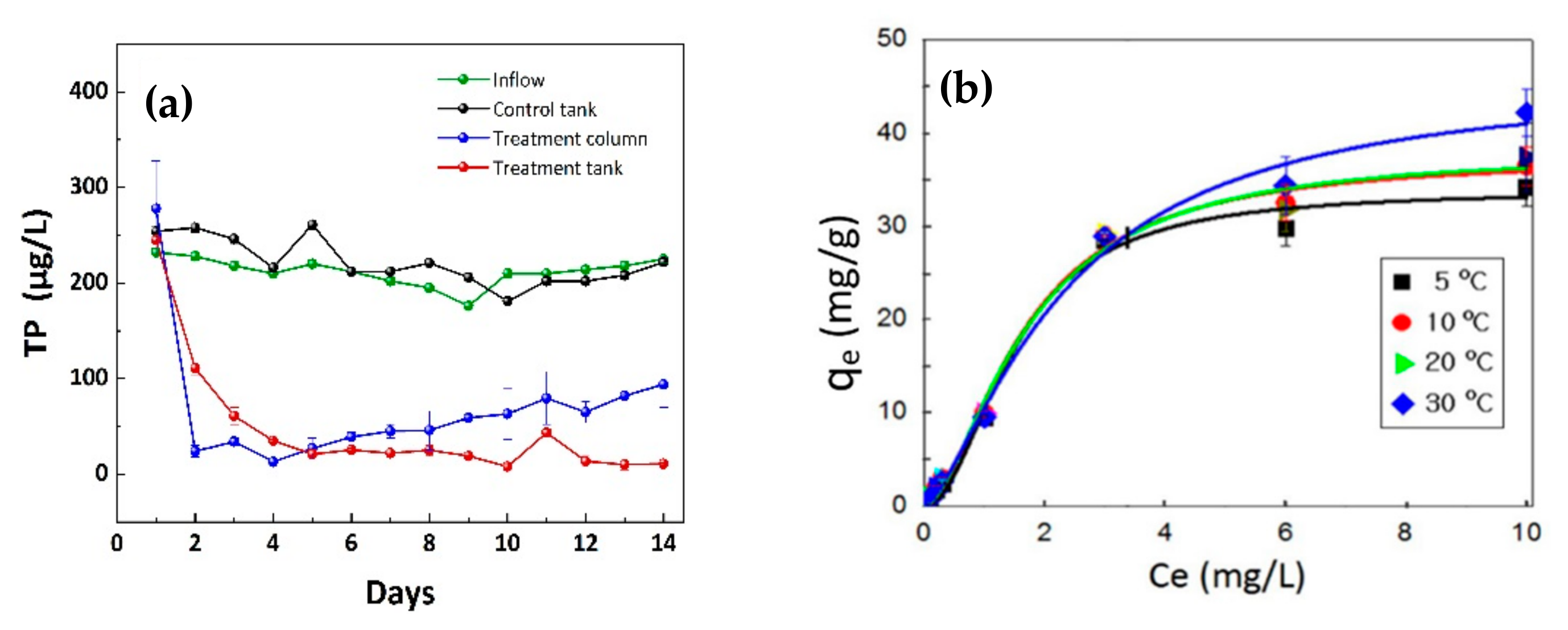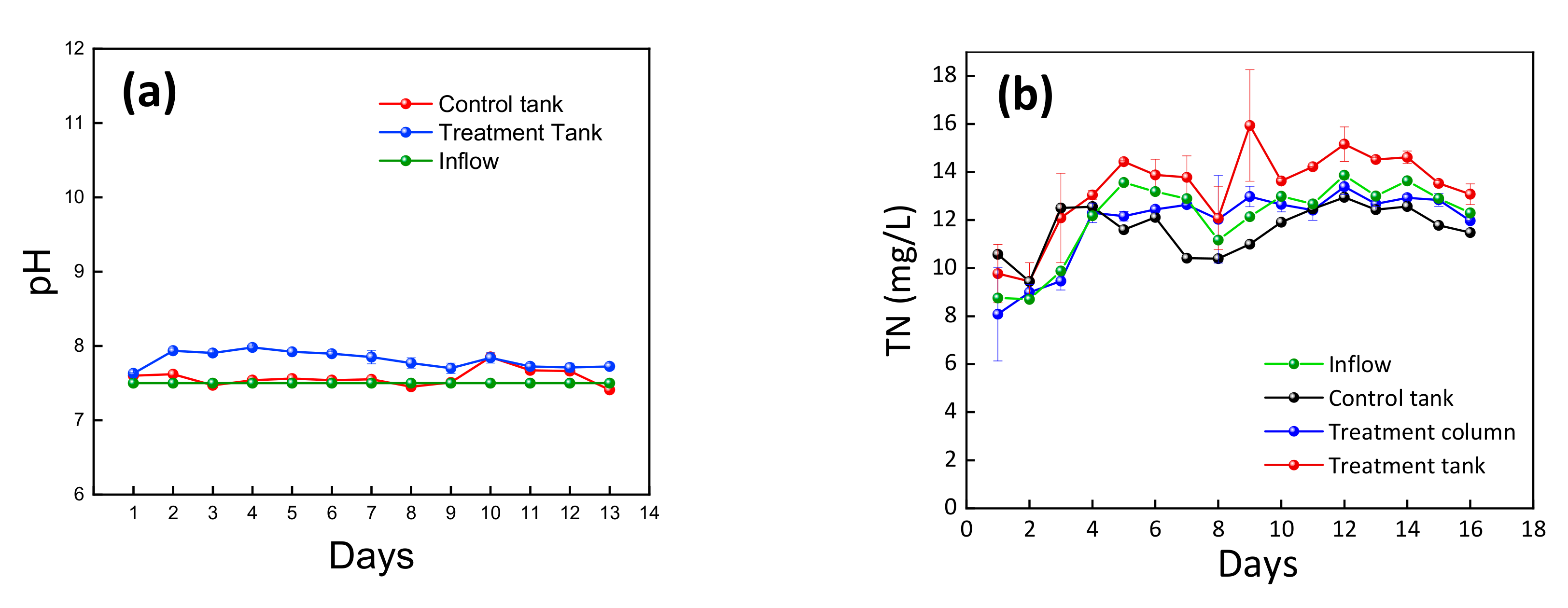Synergistic Recapturing of External and Internal Phosphorus for In Situ Eutrophication Mitigation
Abstract
:1. Introduction
2. Materials and Methods
2.1. Experimental Setup
2.2. P Adsorbents and Inflow Water Preparation
2.3. Sampling and Analysis
2.4. Adsorption Equilibrium Test
3. Results & Discussion
3.1. External and Internal P Recapture
3.2. P Equilibrium Adsorption Capacity and Potential Interaction with Water Quality
3.3. Implementation Feasibility
4. Conclusions
Author Contributions
Funding
Acknowledgments
Conflicts of Interest
References
- Elser, J.; Bennett, E. Phosphorus cycle: A broken biogeochemical cycle. Nature 2011, 478, 29–31. [Google Scholar] [CrossRef] [PubMed]
- Van Vuuren, D.P.; Bouwman, A.F.; Beusen, A.H.W. Phosphorus demand for the 1970–2100 period: A scenario analysis of resource depletion. Glob. Environ. Chang. 2010, 20, 428–439. [Google Scholar] [CrossRef]
- Peñuelas, J.; Poulter, B.; Sardans, J.; Ciais, P.; Velde, M.; Bopp, L.; Boucher, O.; Godderis, Y.; Hinsinger, P.; Llusia, J.; et al. Human-induced nitrogen-phosphorus imbalances alter natural and managed ecosystems across the globe. Nat. Commun. 2013, 4, 2934. [Google Scholar] [CrossRef] [PubMed] [Green Version]
- Pan, G.; Lyu, T.; Mortimer, R. Comment: Closing phosphorus cycle from natural waters: Re-capturing phosphorus through an integrated water-energy-food strategy. J. Environ. Sci.-China 2018, 65, 375–376. [Google Scholar] [CrossRef] [PubMed] [Green Version]
- Richardson, C.J.; King, R.S.; Qian, S.S.; Vaithiyanathan, P.; Qualls, R.; Stow, C.A. Estimating ecological thresholds for phosphours in the everglades. Environ. Sci. Technol. 2007, 41, 8084–8091. [Google Scholar] [CrossRef]
- Carvalho, L.; McDonald, C.; Hoyos, C.D.; Mischke, U.; Phillips, G.; Borics, G.; Poikane, S.; Skjelbred, B.; Solheim, A.L.; Wichelen, J.V.; et al. Sustaining recreational quality of European lakes: Minimizing the health risks from algal blooms through phosphorus control. J. Appl. Ecol. 2013, 50, 315–332. [Google Scholar] [CrossRef] [Green Version]
- Khare, Y.; Naja, G.M.; Stainback, G.A.; Martinez, C.J.; Paudel, R.; van Lent, T. A Phased Assessment of Restoration Alternatives to Achieve Phosphorus Water Quality Targets for Lake Okeechobee, Florida, USA. Water 2019, 11, 327. [Google Scholar] [CrossRef] [Green Version]
- Dierberg, F.E.; DeBusk, T.A.; Jackson, S.D.; Chimney, M.J.; Pietro, K. Submerged aquatic vegetation-based treatment wetlands for removing phosphorus from agricultural runoff: Response to hydraulic and nutrient loading. Water Res. 2002, 36, 1409–1422. [Google Scholar] [CrossRef]
- Grenon, G.; Madramootoo, C.A.; Singh, B.; Gaj, N. Water Quality Management in the Holland Marsh, Ontario; ASABE Annual International Meeting; American Society of Agricultural and Biological Engineers: St. Joseph, MI, USA, 2016; p. 1. [Google Scholar]
- United States Environmental Protection Agency (U.S. EPA). Nutrient Criteria Technical Guidance Manual, Lakes and Reservoirs; Office of Science and Technology: Washington, DC, USA, 2000; p. 822. Available online: https://www.epa.gov/nutrient-policy-data/criteria-development-guidance-lakes-and-reservoirs (accessed on 20 June 2000).
- Genz, A.; Kornmüller, A.; Jekel, M. Advanced phosphorus removal from membrane filtrates by adsorption on activated aluminium oxide and granulated ferric hydorxide. Water Res. 2004, 38, 3523–3530. [Google Scholar] [CrossRef]
- Zhu, X.P.; Jyo, A. Column-mode phosphate removal by a novel highly selective adsorbent. Water Res. 2005, 39, 2301–2308. [Google Scholar] [CrossRef]
- Kumar, P.S.; Korving, L.; van Loosdrecht, M.C.M.; Witkamp, G.J. Adsorption as a technology to achieve ultra-low concentrations of phosphate: Research gaps and economic analysis. Water Res. X 2019, 4, 100029. [Google Scholar] [CrossRef] [PubMed]
- Bhadha, J.H.; Jennewein, S.P.; Khatiwada, R. Phosphorus Sorption Behavior of Torrefied Agricultural Byproducts under Sonicated Versus Non-Sonicated Conditions. Sustain. Agric. Res. 2017, 6, 4. [Google Scholar] [CrossRef] [Green Version]
- Zhou, M.F.; Li, Y.C. Phosphorus-sorption characteristics of calcareous soils and limestone from the southern everglades and adjacent farmlands. Soil Sci. Soc. Am. J. 2000, 65, 1404–1412. [Google Scholar] [CrossRef] [Green Version]
- Proctor, D.; Fehling, K.; Shay, E.; Wittenborn, J.; Green, J.; Avent, C.; Bigham, R.; Connolly, M.; Lee, B.; Shepker, T. Physical and chemical characteristics of blast furnace, basic oxygen furnace, and electric arc furnace steel industry slags. Environ. Sci. Technol. 2000, 34, 1576–1582. [Google Scholar] [CrossRef]
- Lürling, M.; Waajen, G.; van Oosterhout, F. Humic substances interfere with phosphate removal by lanthanum modified clay in controlling eutrophication. Water Res. 2014, 54, 78–88. [Google Scholar] [CrossRef]
- Reitzel, K.; Andersen, F.; Egemose, S.; Jensen, H.S. Phosphate adsorption by lanthanum modified bentonite clay in fresh and brackish water. Water Res. 2013, 47, 2787–2796. [Google Scholar] [CrossRef]
- Kim, D.; Ryoo, K.S.; Hong, Y.P.; Choi, J.H. Evaluation of loess capability for adsorption of total nitrogen (T-N) and total phophorous (T-P) in aqueous solution. Bull Korean Chem. Soc. 2014, 35, 2471–2476. [Google Scholar] [CrossRef] [Green Version]
- Molle, P.; Lienard, A.; Grasmick, A.; Iwema, A. Phosphorus retention in subsurface constructed wetlands: Investigations focused on calcareous materials and their chemical reactions. Water Sci. Technol. 2003, 48, 75–83. [Google Scholar] [CrossRef]
- Drizo, A.; Frost, C.A.; Grace, J.; Smith, K.A. Physico-chemical screening of phosphate-removing substrates for use in constructed wetland systems. Water Res. 1999, 33, 3595–3602. [Google Scholar] [CrossRef]
- Drizo, A.; Forget, C.; Chapuis, R.P.; Comeau, Y. Phosphorus removal by electric arc furnace steel slag and serpentinite. Water Res. 2006, 40, 1547–1554. [Google Scholar] [CrossRef]
- Wang, Y.; Yu, Y.G.; Li, H.Y.; Shen, C.C. Comparison study of phosphorus adsorption on different waste solids: Fly ash, red mud and ferric-alum water treatment residues. J. Environ. Sci.-China. 2016, 50, 79–86. [Google Scholar] [CrossRef] [PubMed]
- Svatos, K.B. Commercial silicate phosphate sequestration and desorption leads to a gradual decline of aquatic systems. Environ. Sci. Pollut. Res. 2018, 25, 5386–5392. [Google Scholar] [CrossRef] [PubMed]
- Gonçalves, M.A.S.C. New Eco-Efficient Polymers for Phosphorus Recovery; Universidade do Minho-Campus de Gualtar: Braga, Portugal, 2012; Available online: https://search.proquest.com/docview/1900972696?pq-origsite=gscholar (accessed on 1 April 2012).
- Xu, R.; Zhang, M.; Mortimer, R.J.; Pan, G. Enhanced phosphorus locking by novel lanthanum/aluminum-hydroxide composite: Implications for eutrophication control. Environ. Sci. Technol. 2017, 51, 3418–3425. [Google Scholar] [CrossRef] [Green Version]
- Iizuka, A.; Sasaki, T.; Hongo, T.; Honma, M.; Hayakawa, Y.; Yamasaki, A.; Yanagisawa, Y. Phosphorus adsorbent derived from concrete sludge (PAdeCS) and its phosphorus recovery performance. Ind. Eng. Chem. Res. 2012, 51, 11266–11273. [Google Scholar] [CrossRef]
- Yin, H.; Kong, M. Simultaneous removal of ammonium and phosphate from eutrophic waters using natural calcium-rich attapulgite-based versatile adsorbent. Desalination 2014, 351, 128–137. [Google Scholar] [CrossRef]
- Hsieh, C.H.; Davis, A.P.; Needelman, B.A. Bioretention column studies of phosphorus removal from urban stormwater runoff. Water Environ. Res. 2007, 79, 177–184. [Google Scholar] [CrossRef]
- Fu, X.Y.; Cui, G.Y.; Huang, K.; Chen, X.M.; Li, F.S.; Zhang, X.Y.; Li, F. Earthworms facilitate the stabilization of pelletized dewatered sludge through shaping microbial biomass and activity and community. Environ. Sci. Pollut. Res. 2016, 23, 4522–4530. [Google Scholar] [CrossRef]
- Ding, Z.B.; Yu, Z.H.; Cheng, T.T.; Zhang, P.; Gao, X. Research on experimental condition of analysing total nitrogen of water by ultraviolet spectrophotometric method. Water Purif. Technol. 2008, 27, 61–64. Available online: http://en.cnki.com.cn/Article_en/CJFDTotal-ZSJS200801018.htm (accessed on 25 January 2008).
- Pang, G.; Liss, P.S. Metastable-equilibrium adsorption theory. J. Colloid Interface Sci. 1998, 201, 71–76. [Google Scholar]
- Xing, X.; Gao, B.; Wang, W.; Yue, Q.; Wang, Y.; Ni, S. Adsorption of phosphate from aqueous solutions onto modified wheat residue: Characteristics, kinetic and column studies. Colloid Surface B 2009, 70, 46–52. [Google Scholar]
- Han, R.; Wang, Y.; Zou, W.; Wang, Y.; Shi, J. Comparison of linear and nonlinear analysis in estimating the Thomas model parameters for methylene blue adsorption onto natural zeolite in fixed-bed column. J. Hazard. Mater. 2007, 145, 331–335. [Google Scholar] [CrossRef]
- Douglas, G.; Hamilton, D.; Robb, M.; Pan, G.; Spears, B.M.; Lurling, M. Guiding principles for the development and application of solid-phase phosphorus adsorbents for freshwater ecosystems. Aquat. Ecol. 2016, 50, 385–405. [Google Scholar] [CrossRef] [Green Version]
- Robb, M.; Greenop, B.; Goss, Z.; Douglas, G.; Adeney, J. Application of Phoslock, an innovative phosphorus binding clay, to two Western Australian waterways: Preliminary findings. Hydrobiologia 2003, 494, 237–243. [Google Scholar] [CrossRef]
- Ozkundakci, D.; Hamilton, D.P.; Scholes, P. Effect of intensive catchment and in-lake restoration procedures on phosphorus concentrations in a eutrophic lake. Ecol. Eng. 2010, 36, 396–405. [Google Scholar] [CrossRef]
- Haghseresht, F.; Wang, S.; Do, D.D. A novel lanthanum-modified bentonite, Phoslock, for phosphate removal from wastewaters. Appl. Clay Sci. 2009, 46, 369–375. [Google Scholar] [CrossRef]
- Conley, D.J.; Paerl, H.W.; Howarth, R.W.; Boesch, D.F.; Seitzinger, S.P.; Havens, K.E.; Lancelot, C.; Likens, G.E. Controlling eutrophication: Nitrogen and phosphorus. Science 2009, 323, 1014–1015. [Google Scholar] [CrossRef]
- Langlois, J.L.; Johnson, D.W.; Mehuys, G.R. Adsorption and recovery of dissolved organic phosphorus and nitrogen by mixed-bed ion-exchange resin. Soil. Sci. Soc. Am. J. 2003, 67, 889–894. [Google Scholar] [CrossRef]



| Category | Name | Adsorption Capacity (mg P/g) |
|---|---|---|
| Natural materials | Soil or sands | 4.2–5.8 [19] |
| Calcite | 4.1 [20] | |
| Limestone | 0.3 [21] | |
| Industrial byproducts | Slags | 2.0–2.3 [22] |
| Fly ash | 6.6 [23] | |
| Red mud | 7 [23] | |
| Modified/synthetic products | Phoslock® | 7.2–75 [24] |
| AlgalBLOCK® | 50 [25] | |
| BaraClear® | 25–55 [24] |
| Temperatures | qe = kCe^1/n | Standard Error | R2 |
|---|---|---|---|
| 5 °C | k = 16.8 | 2.39 | 0.96 |
| 1/n = 0.41 | 0.49 | ||
| 10 °C | k = 22.4 | 4.89 | 0.91 |
| 1/n = 0.29 | 1.56 | ||
| 20 °C | k = 21.7 | 2.35 | 0.96 |
| 1/n = 0.31 | 0.61 | ||
| 30 °C | k = 20.1 | 2.69 | 0.96 |
| 1/n = 0.45 | 0.41 |
© 2019 by the authors. Licensee MDPI, Basel, Switzerland. This article is an open access article distributed under the terms and conditions of the Creative Commons Attribution (CC BY) license (http://creativecommons.org/licenses/by/4.0/).
Share and Cite
Pan, M.; Lyu, T.; Zhang, M.; Zhang, H.; Bi, L.; Wang, L.; Chen, J.; Yao, C.; Ali, J.; Best, S.; et al. Synergistic Recapturing of External and Internal Phosphorus for In Situ Eutrophication Mitigation. Water 2020, 12, 2. https://doi.org/10.3390/w12010002
Pan M, Lyu T, Zhang M, Zhang H, Bi L, Wang L, Chen J, Yao C, Ali J, Best S, et al. Synergistic Recapturing of External and Internal Phosphorus for In Situ Eutrophication Mitigation. Water. 2020; 12(1):2. https://doi.org/10.3390/w12010002
Chicago/Turabian StylePan, Minmin, Tao Lyu, Meiyi Zhang, Honggang Zhang, Lei Bi, Lei Wang, Jun Chen, Chongchao Yao, Jafar Ali, Samantha Best, and et al. 2020. "Synergistic Recapturing of External and Internal Phosphorus for In Situ Eutrophication Mitigation" Water 12, no. 1: 2. https://doi.org/10.3390/w12010002
APA StylePan, M., Lyu, T., Zhang, M., Zhang, H., Bi, L., Wang, L., Chen, J., Yao, C., Ali, J., Best, S., Ray, N., & Pan, G. (2020). Synergistic Recapturing of External and Internal Phosphorus for In Situ Eutrophication Mitigation. Water, 12(1), 2. https://doi.org/10.3390/w12010002









